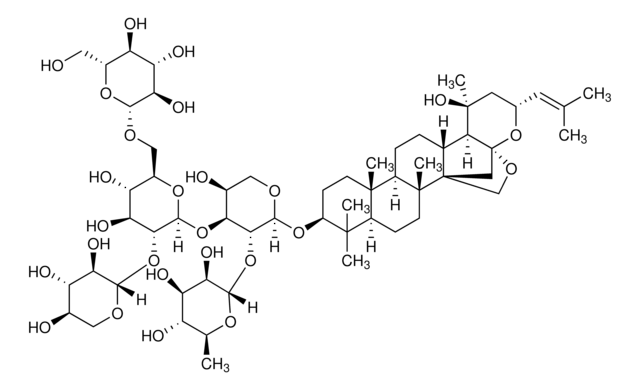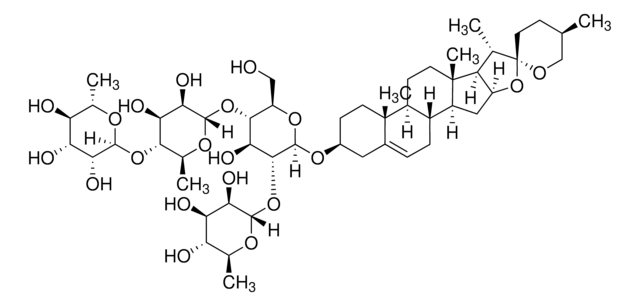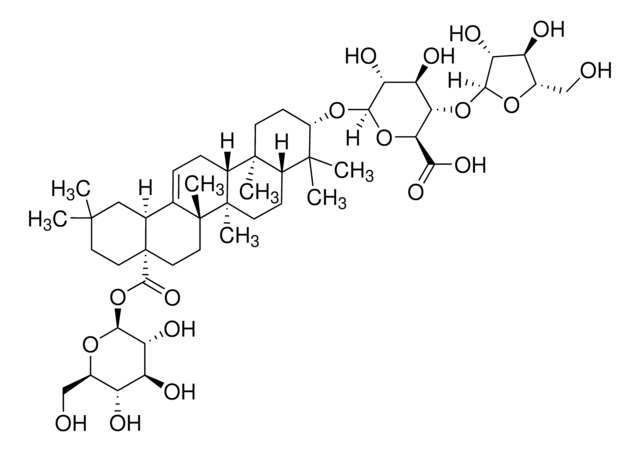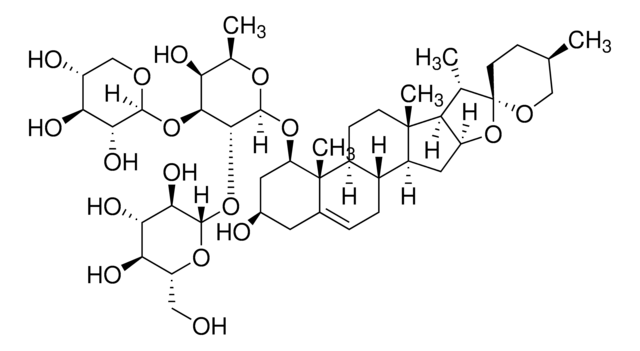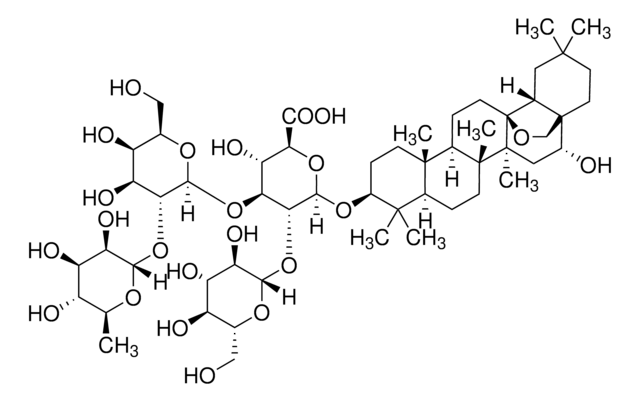SML1822
Akebia saponin D
≥98% (HPLC)
Synonim(y):
3-O-α-L-arabinopyranosyl hederagenin-28-β-D-glucopyranoside-(1→6)-β-D-glucopyranoside, ASD, Asperosaponin VI, Leiyemudanoside A, Tauroside St-G0-1
About This Item
Polecane produkty
pochodzenie biologiczne
(Dipsacus asper)
Poziom jakości
Próba
≥98% (HPLC)
Postać
powder
aktywność optyczna
[α]/D +13 to +18°, c = 0.5 in methanol
warunki przechowywania
desiccated
kolor
white to beige
rozpuszczalność
H2O: 3 mg/mL, clear (warmed)
Warunki transportu
wet ice
temp. przechowywania
−20°C
ciąg SMILES
CC1(C)CC[C@]2(C(O[C@@H]3O[C@H](CO[C@@H]4O[C@H](CO)[C@@H](O)[C@H](O)[C@H]4O)[C@@H](O)[C@H](O)[C@H]3O)=O)CC[C@@]5(C)[C@]6(C)CCC7[C@](C)(CO)[C@@H](O[C@]8([H])OC[C@H](O)[C@H](O)[C@H]8O)CC[C@]7(C)[C@@]6([H])CC=C5[C@]2([H])C1
InChI
1S/C47H76O18/c1-42(2)13-15-47(41(59)65-40-37(58)34(55)32(53)26(63-40)20-61-38-36(57)33(54)31(52)25(18-48)62-38)16-14-45(5)22(23(47)17-42)7-8-28-43(3)11-10-29(64-39-35(56)30(51)24(50)19-60-39)44(4,21-49)27(43)9-12-46(28,45)6/h7,23-40,48-58H,8-21H2,1-6H3/t23-,24-,25+,26+,27+,28+,29-,30-,31+,32+,33-,34-,35+,36+,37+,38+,39-,40-,43-,44-,45+,46+,47-/m0/s1
Klucz InChI
CCRXMHCQWYVXTE-HMRSNRLKSA-N
Szukasz podobnych produktów? Odwiedź Przewodnik dotyczący porównywania produktów
Działania biochem./fizjol.
Kod klasy składowania
11 - Combustible Solids
Klasa zagrożenia wodnego (WGK)
WGK 3
Temperatura zapłonu (°F)
Not applicable
Temperatura zapłonu (°C)
Not applicable
Certyfikaty analizy (CoA)
Poszukaj Certyfikaty analizy (CoA), wpisując numer partii/serii produktów. Numery serii i partii można znaleźć na etykiecie produktu po słowach „seria” lub „partia”.
Masz już ten produkt?
Dokumenty związane z niedawno zakupionymi produktami zostały zamieszczone w Bibliotece dokumentów.
Klienci oglądali również te produkty
Nasz zespół naukowców ma doświadczenie we wszystkich obszarach badań, w tym w naukach przyrodniczych, materiałoznawstwie, syntezie chemicznej, chromatografii, analityce i wielu innych dziedzinach.
Skontaktuj się z zespołem ds. pomocy technicznej




